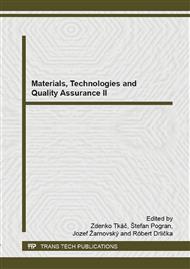[1]
M. M. Alley, D. E. Brann, J. L. Hammons, P. Scharf, W. E. Baethgen, Nitrogen management for winter wheat: Principles and recommendations, Virginia Cooperative Extension Publication 424-026, 1999, information on: http: /www. ext. vt. edu/pubs/grains/424-026/424-026. html#L4.
Google Scholar
[2]
M. Diacono, P. Rubino, F. Montemurro, Precision nitrogen management of wheat. A review, Agron. Sustain. Dev., 33 (2013) 219–241.
DOI: 10.1007/s13593-012-0111-z
Google Scholar
[3]
G. A. Wood, J.P. Welsh, R.J. Godwin, J.C. Taylor, M. Earl, S.M. Knight, Real-time measures of canopy size as a basis for spatially varying nitrogen applications to winter wheat sown at different seed rates, Biosystems Engineering, 84(4) (2003b) 513–531.
DOI: 10.1016/s1537-5110(03)00006-0
Google Scholar
[4]
C. L. Wiegand, S. J. Maas, J. K. Aase, J. L. Hatfiled, P. J. Pinter, R. D. Jackson et al., Multi-site analyses of specral-biolhysical data for wheat, Remote Sensing of Environment, 4 (1992) 1–21.
DOI: 10.1016/0034-4257(92)90064-q
Google Scholar
[5]
L. D. Hinzman, M. E. Bauer, S. T. Daughtry, Effect of nitrogen fertilization on growth and reflectance characteristics of winter wheat, Remote Sensing of Environment, 19 (1986) 47–61.
DOI: 10.1016/0034-4257(86)90040-4
Google Scholar
[6]
L. Serrano, I. Filella, J. Penuelas, Remote sensing of biomass and yield of winter wheat under different nitrogen supplies, Crop Science, 40 (2000) 723–731.
DOI: 10.2135/cropsci2000.403723x
Google Scholar
[7]
N. Aparicio, D. Villegas, J. L. Araus, J. Casadesus, C. Royo, Relationship between growth traits and spectral vegetation indices in durum wheat, Crop Sciences, 42 (2002) 1547–1555.
DOI: 10.2135/cropsci2002.1547
Google Scholar
[8]
E. Boegh, H. Søgaard, N. Broge, C. B. Hasager, N. O. Jensen, K. Schelde, A. Thomsen, Airborne multispectral data for quantifying leaf area index, nitrogen concentration, and photosynthetic efficiency in agriculture, Remote Sensing of Environment, 81 (2002).
DOI: 10.1016/s0034-4257(01)00342-x
Google Scholar
[9]
N. H. Broge, J. V. Mortensen, Deriving green area index and canopy chlorophyll density of winter wheat from spectral reflectance data, Remote Sensing of Environment, 81 (2002) 45–47.
DOI: 10.1016/s0034-4257(01)00332-7
Google Scholar
[10]
P. M. Hansen, J. K. Schjoerring, Reflectance measurement of canopy biomass and nitrogen status in heat crops using normalized difference vegetation indices and partial least squares regression, Remote Sensing of Environment, 86 (2003) 542–553.
DOI: 10.1016/s0034-4257(03)00131-7
Google Scholar
[11]
I. M. Scotford, P. CH. Miller, Applications of spectral reflectance techniques in Northern European cereal production: A review, Biosystems Engineering, 90(3) (2005) 235–250.
DOI: 10.1016/j.biosystemseng.2004.11.010
Google Scholar
[12]
I. M. Scotford, P. CH. Miller, Estimating tiller density and leaf area index of winter wheat using spectral reflectance and ultrasonic sensing techniques, Biosystems Engineering, 89(4) (2004) 395–408.
DOI: 10.1016/j.biosystemseng.2004.08.019
Google Scholar
[13]
F. Li, Y. Miao, S. D. Hennig, M. L. Gnyp, X. Chen, L. Jia, G. Bareth, Evaluating hyperspectral vegetation indices for estimating nitrogen concentration of winter wheat at different growth stages, Precision Agriculture, 11(4) (2010) 335–357.
DOI: 10.1007/s11119-010-9165-6
Google Scholar
[14]
D. D. Francis, Performance of a crop canopy reflectance sensor to assess chlorophyll content, 2005, information on http: /hydrolab. arsusda. gov/RSinARS/cssa/francis. pdf.
Google Scholar
[15]
C. Zhao, Z. Wang, J. Wang, W. Huang, T. Guo, Early detection of canopy nitrogen deficiency in winter wheat (Triticum aestivum, L. ) based on hyperspectral measurement of canopy chlorophyll status, New Zealand Journal of Crop and Horticulture Science, 39 (2011).
DOI: 10.1080/01140671.2011.588713
Google Scholar
[16]
M. Živčák, M. Brestič, K. Olšovská, P. Slamka, Performance index as a sensitive indicator of water stress in Triticum aestivum, L., Plant Soil and Environment, 54 (2008) 133–139.
DOI: 10.17221/392-pse
Google Scholar
[17]
M. Živčák, K. Olšovská, P. Slamka, J. Galambošová, V. Rataj, H.B. Shao, M. Brestič, Application of chlorophyll fluorescence performance indices to assess the wheat photosynthetic functions influenced by nitrogen deficiency, Plant Soil and Environment, 60 (2014).
DOI: 10.17221/73/2014-pse
Google Scholar
[18]
B. Borawska-Jarmułowicz, G. Mastalerczuk, S. Pietkiewicz, M. H. Kalaji, Low temperature and hardening effects on photosynthetic apparatus efficiency and survival of forage grass varieties, Plant, Soil and Environment, 60 (2014) 177–183.
DOI: 10.17221/57/2014-pse
Google Scholar
[19]
H. M Kalaji, G. Schansker, R. J. Ladle et al., Frequently asked questions about in vivo chlorophyll fluorescence: practical issues, Photosynthesis Research (in press) (2014), doi: 10. 1007/s11120-014-0024-6.
Google Scholar
[20]
B. Limbrunner, F. X. Maidl, Non-contact measurement of the actual nitrogen status of winter wheat canopies by laser-induced chlorophyll fluorescence, in: J. Stafford (Ed. ), Precision Agriculture '07, Papers presented at the 6th European Conference on Precision Agriculture, Skiathos, Greece, Wageningen Academic Publ., Wageningen, 2007, p.173.
DOI: 10.1007/s11119-004-1031-y
Google Scholar
[21]
H. J. Heege, S. Reusch, E. Thiessen, Prospects and results for optical systems for site-specific on-the-go control of nitrogen-top-dressing in Germany, Precision Agriculture, 9(3) (2008) 115–131.
DOI: 10.1007/s11119-008-9055-3
Google Scholar
[22]
V. Martinon, E. M. Fadaili, S. Evain, C. Zecha, Multiplex®: An innovative optical sensor for diagnosis, mapping and management of nitrogen on wheat, Precision Agriculture 2011, ECPA, 8 (2011) 547–561.
Google Scholar
[23]
N. Tremblay, Z. Wang, Z. G. Cerovic, Sensing crop nitrogen status with fluorescence indicators. A review, Agron. Sustain. Dev., 32 (2012) 451–464.
DOI: 10.1007/s13593-011-0041-1
Google Scholar
[24]
F. Li, B. Mistele, Y. Hu, X. Yue, S. Yue, Y. Miao, X. Chen, Z. Cui, Q. Meng, U. Schmidhalter, Remotely estimating aerial N status of phenologically differing winter wheat cultivars grown in contrasting climatic and geographic zones in China and Germany, Field Crops Research, 138 (2012).
DOI: 10.1016/j.fcr.2012.09.002
Google Scholar
[25]
F. Li, B. Mistele, Y. Hu, X. Chen, U. Schmidhalter, Optimising three-band spectral indices to assess aerial N concentration, N uptake and aboveground biomass of winter wheat remotely in China and Germany, Journal of Photogrammetry and Remote Sensing, 92 (2014).
DOI: 10.1016/j.isprsjprs.2014.03.006
Google Scholar


